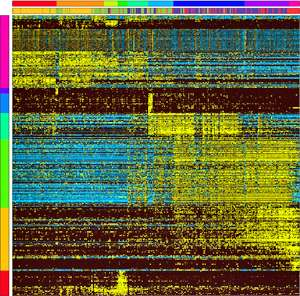
2016年9月3日/生物谷BIOON/–在一项新的研究中,来自美国辛辛那提儿童医院医学中心的研究人员发现发育中的血细胞在最终决定变成哪种类型细胞之前陷入竞争性的基因调控网络之间的拉锯战之中。相关研究结果于2016年8月31日在线发表在Nature期刊上,论文标题为“Single-cell analysis of mixed-lineage states leading to a binary cell fate choice”。论文通信作者为Nathan Salomonis博士、Harinder Singh博士和H. Leighton Grimes博士。
研究人员报道当发育中的血细胞被众多激活和关闭的基因信号触发时,它们在最终变成特定的细胞类型之前在变动的多种细胞系状态之间来回移动。尽管他们仍然不能精确地理解这些细胞如何选择一种最终的命运,但是他们的研究提示着竞争性的基因网络诱导动态的不稳定性,从而导致混合细胞系(mixed-lineage)状态,而这些混合细胞系状态是为准备决定新形成的细胞所必需的。
Singh说,“它有点处于混乱状态,但是次序就是从这种混乱中产生的。这一发现有助我们解决发育生物学上的一个基本问题—这些中间状态和决定细胞类型选择的基因调节网络的性质是什么。”
根据Grimes的说法,尽管这些发现还需开展进一步的广泛研究来更好地理解这种基因过程的来回移动的性质,但是这项研究可能最终为导致疾病的发育错误提供新的认识。
Grimes问道,“血细胞如何知道变成中性粒细胞或单核细胞?你的骨髓三分之二是由这种活动占据的,而且细胞数量必须保持精致的平衡。这两种细胞中的任何一种太多或太少都能够杀死你。”
在当前的这项研究中,研究人员特别地研究中性粒细胞和单核细胞(巨噬细胞)这两种血细胞—免疫系统中至关重要的细胞组分—的形成。他们利用一种新的飞速发展的被称作单细胞RNA测序的技术研究自然状态下发育的小鼠血细胞,其中单细胞RNA测序可鉴定出单个细胞的基因表达程序和它们的推定的调节物。
大数据生物学
研究人员将实验室生物学技术与辛辛那提儿童医院开发的一种新的生物信息学计算机程序(即ICGS)结合在一起。ICGS(Iterative Clustering and Guide-Gene Selection, 迭代聚类与引导基因选择)让人们对单细胞RNA测序产生的巨大数量的数据获得综合的认识。
ICGS
ICGS给研究人员提供一种直观的平台,该平台能够分析所有的测序数据和生物学数据来鉴定细胞—在这项研究中,指的是发育中的血细胞—的多种转移或变化的基因组和细胞状态。
动态不稳定性
人们之前已提出中性粒细胞和巨噬细胞这两种血细胞是由于一种双稳态基因调节网络(能够显示两种稳定状态中的一种)产生的。但是不同的细胞转换状态和发育背后的分子动力学特征仍然是未知的。
通过在不同的实验室生物学之间进行重复性地反复研究和计算分析,研究人员说他们对发育中的血细胞的分析捕获到一种普遍的混合细胞系中间状态。这些中间状态表达一种基因组合,包括能够产生所有血细胞类型的干细胞典型的那些基因,以及红细胞、血小板、巨噬细胞和中性粒细胞特异性的一些基因。这似乎反映了竞争性的基因程序。
研究人员也发现这些发育中的血细胞经历一种罕见的状态,在这种状态下,它们遭遇到被称作“动态不稳定性”的混乱。这似乎是由两种对抗性的髓系细胞基因调节网络所导致的。这两种对抗性基因网络中的两种关键组分是Irf8和Gfi1,即两种参与血细胞形成的基因。这两种基因编码转录因子,这意味着它们编码的蛋白产物控制着哪种基因信息用于细胞形成中。当Irf8和Gfi1被剔除时,研究人员发现这些罕见的细胞能够停留在一种中间状态。
当继续开展研究时,研究人员想要更加清晰地理解是什么最终导致发育中的血细胞处于动态不稳定性的中间状态并从中选择特定的命运。他们提出两种同时存在的抵抗性基因网络的影响产生内部波动,而这些波动最终能够被未知的机制稳定化从而选择两种不同的细胞命运中的一种。(生物谷 Bioon.com)
本文系生物谷原创编译整理,欢迎转载!点击 获取授权 。更多资讯请下载生物谷app。
Single-cell analysis of mixed-lineage states leading to a binary cell fate choice
Andre Olsson, Meenakshi Venkatasubramanian, Viren K. Chaudhri, Bruce J. Aronow, Nathan Salomonis, Harinder Singh & H. Leighton Grimes
doi:10.1038/nature19348
PMC:
PMID:
Delineating hierarchical cellular states, including rare intermediates and the networks of regulatory genes that orchestrate cell-type specification, are continuing challenges for developmental biology. Single-cell RNA sequencing is greatly accelerating such research, given its power to provide comprehensive descriptions of genomic states and their presumptive regulators1, 2, 3, 4, 5. Haematopoietic multipotential progenitor cells, as well as bipotential intermediates, manifest mixed-lineage patterns of gene expression at a single-cell level6, 7. Such mixed-lineage states may reflect the molecular priming of different developmental potentials by co-expressed alternative-lineage determinants, namely transcription factors. Although a bistable gene regulatory network has been proposed to regulate the specification of either neutrophils or macrophages7, 8, the nature of the transition states manifested in vivo, and the underlying dynamics of the cell-fate determinants, have remained elusive. Here we use single-cell RNA sequencing coupled with a new analytic tool, iterative clustering and guide-gene selection, and clonogenic assays to delineate hierarchical genomic and regulatory states that culminate in neutrophil or macrophage specification in mice. We show that this analysis captured prevalent mixed-lineage intermediates that manifested concurrent expression of haematopoietic stem cell/progenitor and myeloid progenitor cell genes. It also revealed rare metastable intermediates that had collapsed the haematopoietic stem cell/progenitor gene expression programme, instead expressing low levels of the myeloid determinants, Irf8 and Gfi1 (refs 9, 10, 11, 12, 13). Genetic perturbations and chromatin immunoprecipitation followed by sequencing revealed Irf8 and Gfi1 as key components of counteracting myeloid-gene-regulatory networks. Combined loss of these two determinants ‘tr apped’ the metastable intermediate. We propose that mixed-lineage states are obligatory during cell-fate specification, manifest differing frequencies because of their dynamic instability and are dictated by counteracting gene-regulatory networks.
 基因君官网
基因君官网